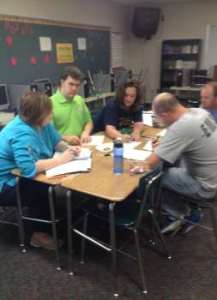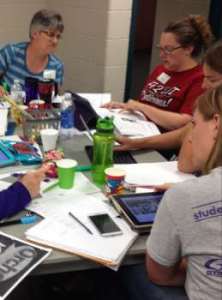Common Core Standards
Teachers Solve Problems in Collaboration to Improve Mathematics Instruction in Project RENEW

We talk a lot about how isolating it can be to be a teacher, but nowhere is that more apparent than in small, rural districts. The teachers there are often the only instructor for a single subject. This is especially difficult for such an important and variable subject as mathematics. As Phillips and Hughes explain:
“Too often, teachers do not have sufficient opportunities to work together to examine work and structure interventions within their classrooms.
As the new standards are implemented, we must ensure that teachers are not left alone to figure out how best to teach to them.
The standards are an opportunity for greater collaboration, fresher thinking, and a rearticulation of shared goals for teachers and students.
By collaborating with each other and with instructional specialists through cycles of examining student work, creating hypotheses about how to implement common-core-aligned lessons, implementing them, and making adjustments in their practice in real time, teachers can find the best ways to help their students reach these higher expectations while still maintaining individual styles and flexibility.” (2012, Education Week)
With multiple levels and subjects within it, math is a daunting subject to teach. But that’s what the educators at West Elementary School in Manhattan, Kansas plan to do.
What is Project RENEW?
Project RENEW emphasizes the development of deeper content knowledge among teachers, as well as pedagogical knowledge aligned with a standards-based approach to content teaching. By building a cadre of elite math educators, the teachers at West Elementary School aim to create an easily adoptable model to improve math scores within their district and beyond.
What are the project goals?

With the adoption of a much more rigorous set of standards, Common Core Standards for Mathematics (CCSSM), the teachers at West Elementary realized that they must rethink how they teach mathematics. So, they came up with the following goals:
- Increase student achievement in mathematics for ALL students in grades K-12.
- Strengthen the content and pedagogical knowledge of K-12 teachers.
- Increase the implementation of CCSS-based mathematics instruction and curriculum in K-12 classrooms.
- Strengthen and expand existing leadership opportunities for teachers in mathematics to enhance collaboration to address the needs of K-12 schools, especially in small rural school districts.
The project proposed that by completing goals two through four (strengthening teachers, instruction and math leadership) that goal one (improved student achievement in math) would follow shortly after.
How did this project strengthen teaching in mathematics?
Project participants attended a summer math academy to develop CCSSM aligned curriculum and tasks. This academy helped the group understand their current practice and focus on ways to improve it.

First, teachers were pre-tested on their mathematical knowledge in relation to how they would implement mathematical practices in the classroom and had to submit an “action plan related to these practices and instructional strategies used for implementation.”
Next, they were observed during instruction and given feedback during professional development sessions.
In addition to this, teachers in smaller districts nearby that do not have funding for professional development and/or resources were contacted by the teachers from Project RENEW. Together, they were able to share resources and provide professional development for these small districts. Funds provided by McCarthey Dressman Education Foundation were also used to purchase new materials for the academy, so they were able to box up their “used” standards-based textbooks, load them up in a truck and delivered them to four different districts in the area.
How did this project impact the math instruction?
After a year of funding they’ve improved “by leaps and bounds and are ready to tackle the next steps” according to the project report.
The difference between the teacher Pre-Test and Post-Test was phenomenal. The average score starting out was a 2/7 correct responses and by the end that average had improved to 5/7. That’s 42.8% improvement in teacher knowledge of how to implement math instruction for CCSSM.
Teachers were also observed showing marked improvements on their in class instructional skills, particularly in the realm of “providing problem solving opportunities for their students, requiring productive struggle and discourse.”
To further extend the benefits of the program in their community, the teachers involved in the project were also responsible for disseminating what they learned in professional development sessions with the smaller districts.
What knowledge would they share with teachers exploring similar projects?
Like many of these ambitious projects one of the hurdles that must be overcome is the lack of resources. Even with the grant funding, they were unable to accommodate all the educators they would have liked to. The waitlist for additional involvement is long and shows no sign of letting up, much to the disappointment of those who know the project’s promise. In the future, they plan to video tape the lessons to help smaller districts to gain access to this valuable resource. This will be a focus in the year to come.
Also of note, the implementation of this program might encounter challenges operating on a larger scale due to the vast time requirements put on the educators and the stipends needed to cover their time. They hope that in the coming years that the texts, videos, and seminars resulting from this program will be able to be adapted for use by other districts and schools around the country.
Further Readings
- Report: Teacher Leadership Is Key to Common Core Success (2015, THE Journal)
- Teacher Leadership, Collaboration, and Common Core State Standards (2015, Learning First Alliance)
- Teacher Collaboration: Keys to Common Core Success (2014, AMLE)
- Teacher Collaboration: The Essential Common-Core Ingredient (2012, Education Week)
Additional Resources
Minority and economically disadvantaged students benefit from unique enrichment programs
Quote Posted on Updated on
-Sarah J. McCarthey, President
McCarthey Dressman Education Foundation

Related articles
- Common Core and Disadvantaged Students (edweek.org)










